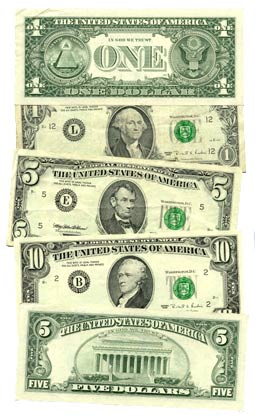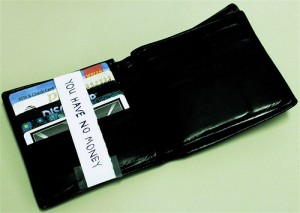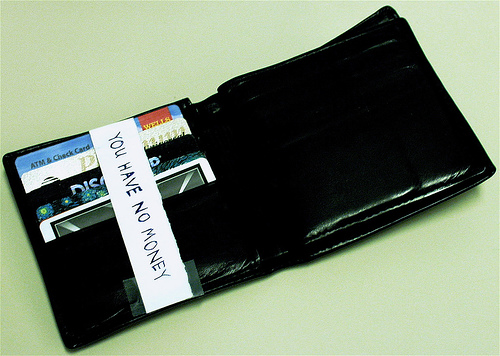- Dora the Explorer is singing about cocaine. Is that why my kids have so much energy? #
- RT @prosperousfool: Be the Friendly Financial “Stop” Sign http://bit.ly/67NZFH #
- RT @tferriss: Aldous Huxley’s ‘Brave New World’ in a one-page cartoon: http://su.pr/2PAuup #
- RT @BSimple: Shallow men believe in Luck, Strong men believe in cause and effect. Ralph Waldo Emerson #
- 5am finally pays off. 800 word post finished. Reading to the kids has been more consistent,too. Not req’ing bedtime, just reading daily. #
- Titty Mouse and Tatty Mouse: morbid story from my childhood. Still enthralling. #
- RT @MoneyCrashers: Money Crashers 2010 New Year Giveaway Bash – $7,400 in Cash and Amazing Prizes http://bt.io/DDPy #
- [Read more…] about Twitter Weekly Updates for 2010-01-16
I just turned 2!
Update: Over $500 in prizes!
Yesterday was my second anniversary here. For the last two years, I have shared my thoughts, feelings, and finances three times a week and you have been there to watch and share as I figure out my financial future.
I appreciate it.
To show my appreciation, I’m giving stuff away.
Here are the prizes:
1 $100 prize
1 $75 prize
6 $25 prizes, courtesy of ThirtySixMonths, Budgeting in the Fun Stuff, Maximizing Money, Personal Finance Whiz, and Broke Professionals.
1 iPod Shuffle courtesy of Prairie Eco-Thrifter.
1 $25 Amazon gift card courtesy of Beating Broke.
A copy of each of the iPhone and iPad versions of the Pay Off Debt app from The Debt Myth
1 $20 Amazon gift card, courtesy of Money Crush.
1 $25 Starbuck’s gift card, courtesy of Mom’s Plans.
I’m also giving away some books, some of which have been lightly read.
Financial Peace Revisited by Dave Ramsey
Never Pay Retail by Sid Kirchheimer
Delivering Happiness (advanced reader copy) by Tony Hsieh
I Will Teach You To Be Rich by Ramit Sethi
The Art of Non-Conformity by Chris Guillebeau
CreditCards.com Book of Cartoons
Women & Money by Suze Orman
To enter:
Follow the instuctions in the widget below. Following me on Facebook, Twitter, RSS, or email will all earn entries. Following any of the sponsors on Twitter of Facebook will earn you entries. Tweeting about the giveaway as often as you like or linking to this page on your site will earn you entries.
There are lots of ways to enter and 16 prizes to win.
The drawing will be held on December 23rd, just in time to give you some cash before Christmas.
Good luck!
Side Hustle: Garage Sale Wrap-Up
We are now to the end of Garage Sale Week here at Live Real, Now. I hope you’ve enjoyed it.
After you shut down on the last day, take the evening off. You’ve just been hard at work for 2-3 days and need a break. Deal with the stuff tomorrow. Tomorrow–and probably the next few days–you’ve got work to do. What do you do with everything that didn’t sell? If you’re planning on making garage sales a regular side-hustle, just box it all up and put it to the side until next time. After all, it’s all priced, sorted, and ready-to-go, right? If, like me, your goal was to declutter, then it’s time for some serious downsizing. Let’s dump the crap.
The first thing we did was box up all of the books and movies to bring to the used book store. We dropped the items at the sell table and spent half an hour browsing a bookstore. That’s never a good way for me to save money. The store we went to checks the demand for everything you bring in. If there’s no demand, they donate or recycle the items and you don’t get paid. DVDs bring about $1 each. VHS is demand-based. Paperbacks are something less than half of the retail price. Hardcovers are demand-based. We were offered $28 and pointed to the huge pile of discard/recycle items that we were free to reclaim. I picked out 4-5 books and movies that I thought had value and left the rest. Bringing the clutter back home would defeat the purpose of going there.
The clothes were handled two ways. First, all of the little girl clothes were bagged and set aside for some friends with a little girl. The rest were bagged and loaded in the truck for a run to Goodwill. The clothes filled the box of our pickup.
The random knick-knacks were also boxed up and delivered to Goodwill, along with most of the leftover toys. This was another completely full truck box. We had a lot of stuff in our sale.
The beat-up or low-value furniture that didn’t sell was put on the curb with “FREE” signs. I posted the free items on Craigslist and they were gone in just a few hours. The Craigslist ad said “Please do not contact, I will remove the listing when the items are gone.” Otherwise, there are usually 10-15 emails per hour asking if the items are still available. The ad didn’t even have pictures and it worked quickly.
Some of the furniture–the toddler bed, changing table, china cabinet, and the good computer desk–were hauled back to our garage to post on Craigslist with a price-tag. They are too good to give away. If the camera wouldn’t have died two nights ago, the pictures would already be up. Some of the other items were also reserved for individual sale. The extra router, the 6 inch LCD screen, and a few other toys will go on Ebay.
Finally there was some stuff that we decided we weren’t going to get rid of. We kept a few movies, but only because I didn’t notice them until I got back from the bookstore. My wife kept a box of Partylite stuff–though most of the leftovers were donated. Very little of the things we had ready for sale are being kept in our lives. Almost all of it is gone, or will be soon.
All in all, this was a cathartic end to last month’s 30 Day Project. There was some surprising emotional attachment to some things I didn’t think I cared about. It’s good to see it gone.
Note: The entire series is contained in the Garage Sale Manual on the sidebar.
Ignore Your Budget
For the first year of our journey out of debt, we had a strict budget, with all of our discretionary money spent out of an envelope system. We had an envelope for groceries, one for discretionary spending, one for clothes and one for baby crap. At the beginning of the month, we’d divide the money into the envelopes according to our budget spreadsheet. If we used a card for anything, we’d take a matching about of money out of the appropriate envelope and put it in a box to get reconciled the next month.
Ugh. Almost 2 years later, it has turned into too much work and too much nagging about everything either of us put on a card.
We decided to simplify the system a few months ago. Now, we still have a budget. It’s even a zero-based budget, but we ignore it. We only look at it if something changes for the worse. If something changes for the better, the extra money just gets automatically rolled into our debt snowball, so there’s no need to worry about updating the spreadsheet.
Instead of envelopes, we kind of eyeball it. We budget $450 per month for groceries, so we aim to spend $100 on our weekly grocery run. That leaves some room for losing track of how much we are putting in the cart, or a last minute addition to the list. It also leaves room for our secondary grocery trip to buy bread and milk later in the week. We do go through a lot of milk at my house. We budget $55 per month for diapers, but the deal we are currently getting with Amazon Mom is only costing us $30.79 for 6 weeks of diapers. We ignore the difference.
This—and our heavily automated bill pay and savings—lets us keep our finances on track, without stressing over every dollar or fighting over every little thing that comes home unplanned. I used to fire up Quicken and balance the checkbook every week. Now, that happens at the beginning of the month, usually. If I forget, it doesn’t matter. At the beginning of February, I balanced the checkbook for the first time in almost two months and we never came close to exercising our overdraft protection account. In fact, we had some extra, so that got sent directly to our debt.
Overall, it’s been good to test out a new system. We have almost no financial stress and managing our money takes about a couple of hours per month instead of per week. It’s all win.
3 Things Everyone Should Do Before the End of 2010

- Image via Wikipedia
New Year’s resolutions are great, but what are you doing the rest of the year? As we roll into summer and we see the year’s halfway point approaching, it’s important to look at our goals and our progress and see if we’re on track for where we want to be in our lives.
Financially, now is the time to start preparing for the new year. Don’t be like most people and wait until December to think about it.
Here’s a place to start:
- Max out your 401(k). If you are under 50 years old, your maximum annual contribution is $16,500. If you haven’t contributed to your 401(k), yet, this means you will have to deposit $2358 per month to max it out. If you would have started at the beginning of the year it would only be $1375 per month. If those numbers are out of reach, at least contribute enough to get your employer’s match. If your company matches 50% of your contribution up to 5%, you need to be contributing 5%. If your gross paycheck is $1000, you should contribute $50. If you do so, your company will be giving you $25. That’s free money and a 2.5% raise! With a pre-tax contribution, you are also lowering your taxable wage, so the 5% contribution is not lowering your take-home pay by 5%. In some cases, it may even raise your take-home pay!
- Know your money. Take some time to examine your income and your expenses. What are you having withheld? Will that leave you with a large tax bill next spring? Will it give you a huge tax refund, which is just an interest-free loan to the government? You withholding goal should be to pay nothing and receive nothing when you file your taxes in the spring. The less you withhold, the more you have for your daily expenses, but, if you withhold too much, you risk an unaffordable tax bill and possible penalties later. Look also at your expenses. Have you used your gym membership in the last few months? Cancel it. Do you know every cent you have to pay each month? Figure it out so you can plan the rest of your financial year. A budget is helpful here.
- Own your debt. “It’s not my fault.” “My ex stole my bank account.” “My dog ate the bill.” “My kidneys were stolen and I woke up in a bathtub full of ice and an invoice for services rendered.” “I lost my job.” “I have an X-Box addiction.” “I gave my credit card to a stripper, but we broke up. Go after the stripper.” Excuses. Here’s the thing: None of it matters. You owe the debt. Your choices are to pay the debt or file bankruptcy. Either way, you need to own the debt and take responsibility for whatever choices you made or debt you’ve accumulated. Denial is not a successful coping mechanism. Whatever you choose to do, know that it is your choice. You can’t hide from your bills or your $15/day “Venti Soy Hazelnut Vanilla Cinnamon White Mocha with extra White Mocha and caramel” habit.
[ad name=”inlineleft”]
What are your financial plans for the rest of the year?
Update: This post has been included in the Festival of Frugality.
My Financial Plan – How I Improve on Ramsey
In April, my wife and I decided that debt was done. We have hopefully closed that chapter in our lives. I borrowed, then purchased, The Total Money Makeover by Dave Ramsey.  budget” width=”300″ height=”213″ />We are almost following his baby steps. Our credit has always been spectacular, but we used it a lot. Our financial plan is Dave Ramsey’s The Total Money Makeover, with some adjustments.
budget” width=”300″ height=”213″ />We are almost following his baby steps. Our credit has always been spectacular, but we used it a lot. Our financial plan is Dave Ramsey’s The Total Money Makeover, with some adjustments.
Step 1. Budget:
The budget was painful, and for the first couple of months, impossible. We had no idea what bills were coming due. There were quarterly payments for the garbage bill and annual payments for the auto club. It was all a surprise. Surprises are setbacks in a budget.
When something came up, we’d start budgeting for it, but stuff kept coming up. We’re not on top of all of it, yet, but we are so much closer. We’ve got a virtual envelope system for groceries, auto maintenance, baby needs(we have two in diapers) and some discretionary money. We set aside money for everything that isn’t a monthly expense, and have a line item for everything that is. My wife is eligible for overtime and monthly bonuses. That money does not get budgeted. It’s all extra and goes straight on to debt, or to play catch-up with the bills we had previously missed. I figure it will take a full year to get all of the non-monthly expenses in the budget and caught up.
Step 2. The initial emergency fund:
Ramsey recommends $1000, adjusted for your situation. I decided $1000 wasn’t enough. That isn’t even a month’s worth of expenses. We settled on $1800, plus $25/month. It’s still not enough, but it’s better. Hopefully, we’ll be able to ignore it long enough that the $25/month accrues to something worthwhile.
Step 3. The Debt Snowball:
This is the controversial bad math. Pay off the lowest balance accounts first, then take those payments and apply them to the higher balance accounts. Emotionally, it’s been wonderful. We paid off the first credit card in a couple of weeks, followed 6 weeks later by my student loan. Since April, we’ve dropped nearly $10,000 and we haven’t made huge cuts to our standard of living. At least monthly, we re-examine our expenses to see what else can be cut.
Step 4. Three to six months of expenses in savings:
We aren’t on this step yet. In step 2, we are consistently depositing more, making us more secure every month.
Step 5. Invest 15% of household income into Roth IRAs and pre-tax retirement:
I have not stopped my auto-deposited contribution. It’s stupid to pass up an employer match. My wife’s company does not match, so she is currently not contributing.
Step 6. College funding for children:
We have started a $10 College fund.
Step 7. Pay off home early:
I don’t see the point in handling this one separately. Our mortgage is debt, and when the other debts are paid, we will be less than a year from owning our house, free and clear. This is rolled in with step three. All debt is going away, immediately.
Step 8. Build wealth and give!
We have cut off most of our charitable giving. Every other year, it has been a significant percent of our income, and in a few more years, will be so again. The only exception to this is children knocking on the door for fundraisers. I have no problems with saying no to a parent fundraising for their kid, but when the kids is doing the work, door-to-door, especially in the winter, I buy something. My son’s school, on the other hand, gets fundraisers ignored. When they come home, I send a check to the school, ignoring the program. I bypass the overhead and make a direct donation.



